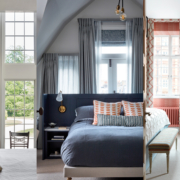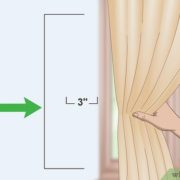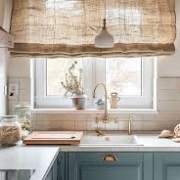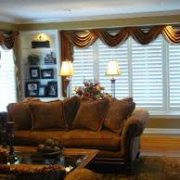How to make windows look bigger with curtains and shades
Make Windows Look Bigger:
- Hang curtains higher than the window to create the illusion of height
- Use light, neutral colors for the curtains to blend into the walls
- Choose curtains with a horizontal pattern to widen the appearance of the window
- Keep curtains full and gathered to maximize the amount of light entering the room
- Use a valance or cornice to extend the width of the window
Make Curtains Look Fuller:
- Use multiple panels to increase fullness
- opt for heavier fabrics such as velvet or heavy linen
- Add tiebacks to pull the curtains away from the window and add volume
- Use a curtain rod with a wider diameter to create a fuller appearance
- Use pinch-pleated or goblet-pleated curtain headings
Choose Curtain Color:
- Consider the room’s existing color scheme and choose curtains that complement it
- Choose lighter colors to brighten up a room, or darker colors to make it more cozy
- Use bold, patterned curtains to add interest to a neutral room
- For a cohesive look, choose curtains that match or coordinate with throw pillows or other textiles
- Consider the room’s purpose and select a curtain color that reflects it, for example, calming blues for a bedroom or cheerful yellows for a playroom.
Are curtains and shades the same thing?
No, curtains and shades are not the same thing.
Curtains are a type of window covering made of fabric, typically hung on a rod or track and used to decorate a room. They come in a variety of colors, patterns, and styles and offer a flexible way to control light, privacy, and insulation.
Shades are a type of window covering that rolls or folds up and down, typically made of fabric or a solid material such as wood or bamboo. They offer more precise control of light and privacy and can be used to block out light completely. Some shades, like Roman shades, can also add texture and style to a room.
Both curtains and shades have their own unique benefits and can be used separately or together to enhance a room’s décor and functionality.
Do shades and curtains go together?
Yes, shades and curtains can go together. In fact, combining the two types of window coverings can provide an additional layer of privacy, light control, and insulation, as well as enhance the overall look of a room.
For example, using sheer or light-filtering curtains over roller or roman shades can provide privacy while still allowing light to enter the room. On the other hand, using opaque curtains over cellular shades can provide complete light blockage, ideal for bedrooms or media rooms.
The combination of shades and curtains can also be used to achieve different decorating styles, such as layering patterns and textures for a more eclectic look or choosing coordinating colors for a more cohesive and polished look.
What are shades in curtains?
In the context of curtains, “shades” refers to the portion of the curtain that is responsible for controlling the amount of light that enters a room. Some curtains come with built-in shades, which can be either light-filtering or opaque.
Light-filtering shades allow a certain amount of light to pass through the fabric, creating a soft and warm ambiance in the room. They are often made of sheer or semi-sheer materials and can be used to provide privacy while still letting in natural light.
Opaque shades, on the other hand, block out all light and are used to create complete privacy and darkness in the room. They are often made of heavy-duty materials such as suede, velvet, or black-out fabric.
The shade component of curtains can be adjusted by opening or closing the curtains, or by using drawstrings or cords to control the amount of light that enters the room. By combining light-filtering and opaque shades, curtains offer a versatile and flexible way to control the lighting in a room.
Are curtains or shades better?
Neither curtains nor shades are inherently better than the other; it depends on your personal preferences, needs, and the specific use case.
Curtains offer more versatility in terms of style and decor, as they come in a variety of colors, patterns, and fabrics, and can be used to enhance the overall look of a room. They also provide a flexible way to control light, privacy, and insulation, as you can adjust the amount of light entering the room by opening or closing the curtains.
Shades, on the other hand, offer more precise control of light and privacy and can be used to block out light completely. They also tend to be easier to clean and maintain than curtains, as they can simply be wiped down with a damp cloth. Some shades, such as cellular shades, can also provide insulation, making them a great choice for energy-efficient homes.
Ultimately, the choice between curtains and shades will depend on your personal preferences and the specific needs of the room in question. For example, if you’re looking for a decorative touch, curtains might be the better choice. If you’re looking for a more functional and low-maintenance option, shades might be a better choice.
What are the three types of shades?
The three main types of shades are:
Roller Shades: Roller shades are a classic and simple option that roll up or down to control light and privacy. They can be made of fabric, vinyl, or other materials and come in a range of colors and patterns. They are a great choice for a clean, modern look.
Roman Shades: Roman shades are a type of fabric shade that folds up neatly when raised and lays flat when lowered. They can be made of a variety of materials, including light-filtering fabrics, and come in a range of styles, from classic to modern.
Cellular Shades: Cellular shades, also known as honeycomb shades, are a popular option for their energy-efficient properties. They have a unique cell structure that traps air to create an insulating barrier, helping to regulate the temperature of the room. They come in a range of colors and fabrics, from light-filtering to opaque, and can be operated manually or with a motorized system.
These are the main types of shades, but there are also other options available, such as pleated shades, bamboo shades, and sheer shades. The best type of shade for you will depend on your specific needs and preferences.
What are the 3 types of curtains?
Sheers: Sheer curtains are made of lightweight, semi-transparent fabric and are often used to filter light and add privacy to a room. They come in a range of colors and styles, from solid to patterned, and can be hung alone or layered with other curtains for a more decorative look.
Drapes: Drapes are a type of full-length curtain that can be opened or closed to control light and privacy. They are typically made of heavier fabric and come in a range of colors and styles, from solid to patterned. Drapes can be used to create a formal or traditional look in a room.
Valances: Valances are a type of decorative curtain that covers the top of a window and can be used to add style and color to a room. They are typically made of lightweight fabric and come in a range of styles, from simple to elaborate. Valances can be used alone or in combination with other types of curtains for a layered look.
These are the main types of curtains, but there are many other styles and variations available, including grommet curtains, tab-top curtains, and pinch-pleat curtains. The best type of curtain for you will depend on your specific needs and preferences.












Leave a Reply
Want to join the discussion?Feel free to contribute!